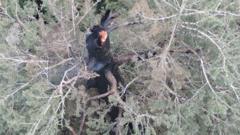Firefighting crews in Oregon are urgently working to protect the Doerner Fir, one of the tallest and oldest trees on the planet, as a wildfire continues to rage nearby. This majestic fir, which towers at over 325 feet (99 meters) and is estimated to be more than 450 years old, has already suffered the loss of approximately 50 feet of its height due to the flames. Fire officials have indicated that the damage could potentially affect its standing in the global height rankings for trees.
As hot and dry weather persists along the Oregon Coast Range, firefighters are facing challenges in their efforts to fully extinguish the blaze. Some innovative methods have been discussed to combat the fire, including the construction of scaffolding to access and quell flames at the higher elevations of the tree. The origin of the fire remains undetermined, with lightning as a possible cause ruled out.
On Tuesday, an infrared drone monitoring the situation revealed no visible flames or smoke among the treetop, but it did identify heat emanating from within a cavity located 280 feet up in the trunk, according to Megan Harper, spokesperson for the federal Bureau of Land Management. She commented on the impact of the fire on the tree's stature, noting, "We've lost about 50 ft of it, just from fire and pieces falling out... I don't know where it'll stand after this, but it's still a magnificent tree."
Fortunately, there is reassurance that the Doerner Fir is unlikely to be completely consumed by flames. Harper explained that the tree's substantial mass means it would take considerable time for the fire to burn all the way through. The Coos Forest Protective Association has reported that helicopter bucket drops have minimized fire activity near the top, while sprinkler systems and containment lines are established around the base of the tree. A helicopter remains on constant standby to assist in firefighting efforts.
As hot and dry weather persists along the Oregon Coast Range, firefighters are facing challenges in their efforts to fully extinguish the blaze. Some innovative methods have been discussed to combat the fire, including the construction of scaffolding to access and quell flames at the higher elevations of the tree. The origin of the fire remains undetermined, with lightning as a possible cause ruled out.
On Tuesday, an infrared drone monitoring the situation revealed no visible flames or smoke among the treetop, but it did identify heat emanating from within a cavity located 280 feet up in the trunk, according to Megan Harper, spokesperson for the federal Bureau of Land Management. She commented on the impact of the fire on the tree's stature, noting, "We've lost about 50 ft of it, just from fire and pieces falling out... I don't know where it'll stand after this, but it's still a magnificent tree."
Fortunately, there is reassurance that the Doerner Fir is unlikely to be completely consumed by flames. Harper explained that the tree's substantial mass means it would take considerable time for the fire to burn all the way through. The Coos Forest Protective Association has reported that helicopter bucket drops have minimized fire activity near the top, while sprinkler systems and containment lines are established around the base of the tree. A helicopter remains on constant standby to assist in firefighting efforts.

















